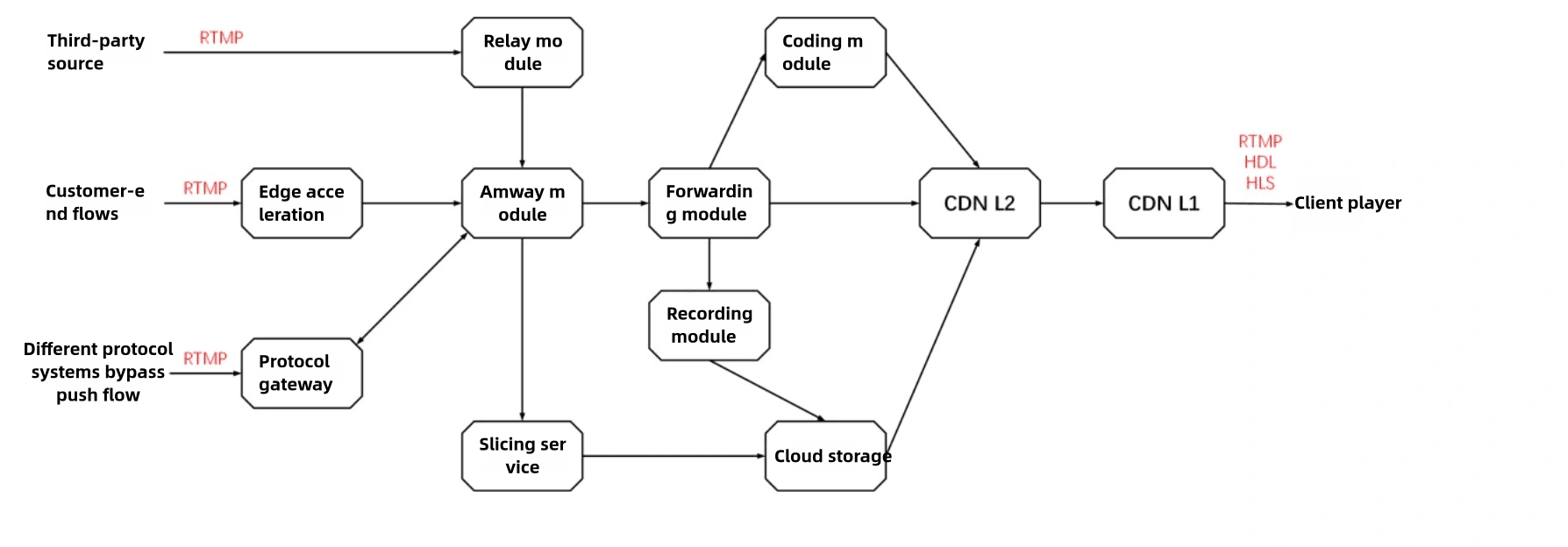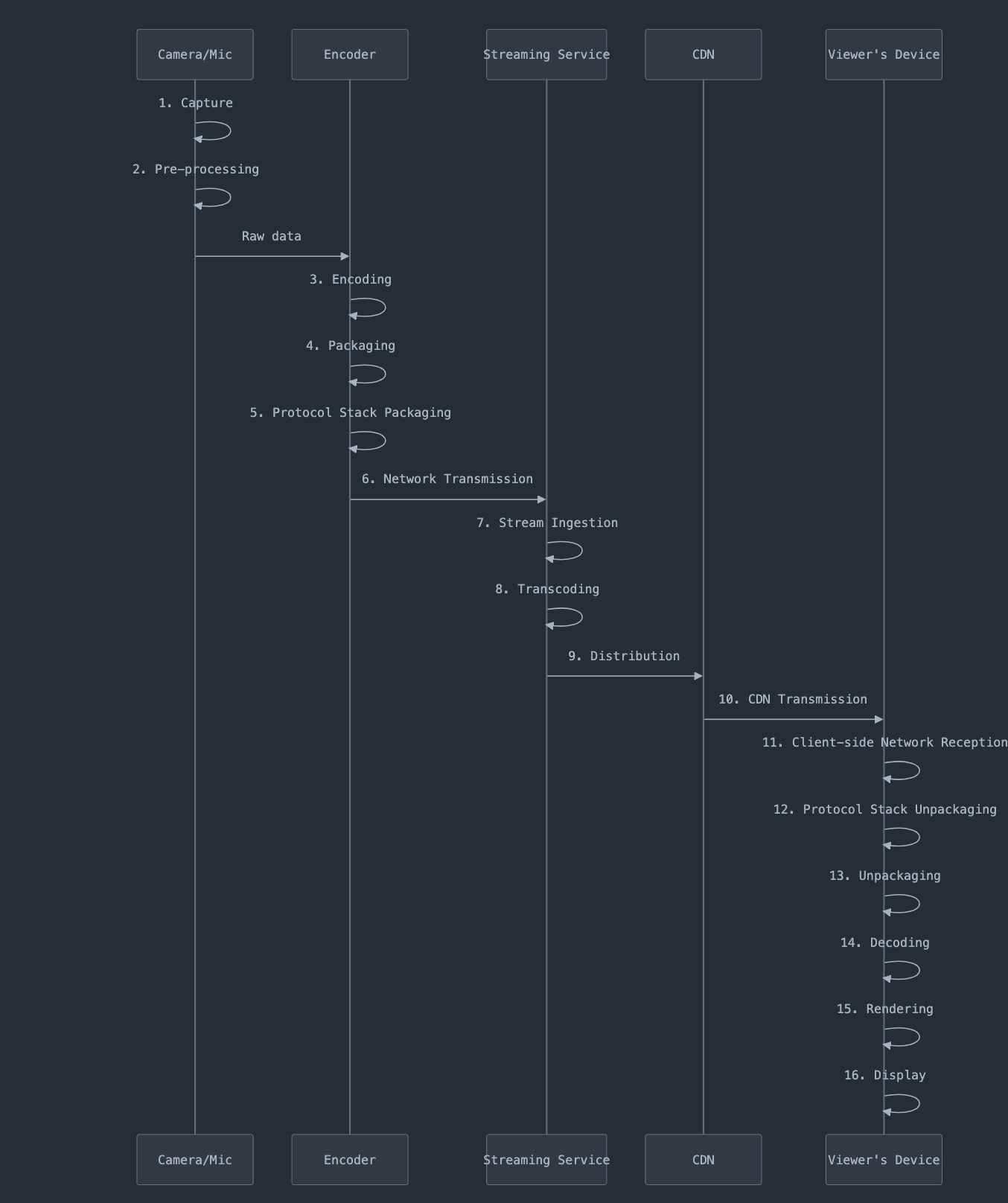In the digital age, live streaming has become an integral part of our online experience. From gaming broadcasts to live news coverage, the technology behind these real-time video transmissions is both complex and fascinating. This blog post will explore the intricate architecture of live streaming services, breaking down each component and explaining how they work together to deliver seamless live video experiences.
Overview of Live Streaming Architecture
Live streaming services are built on a sophisticated infrastructure that handles everything from video capture to delivery. Let's start by looking at a high-level overview of a typical live streaming architecture:

This diagram illustrates the various components involved in a live streaming service. We'll dive into each of these components in detail throughout this post.
Sources of Live Video
Live video can originate from several sources:
Client-side Streaming Tools: These include popular software like OBS (Open Broadcaster Software) and mobile SDKs like the Tencent Cloud Mobile Live SDK. These tools allow users to capture and stream video directly from their devices.
Third-party Stream Sources: This could be streams from other providers or existing public streams that are being rebroadcast.
Other Protocol Systems: For example, streams that are routed from real-time audio-video systems.
The Stream Ingestion Module
The stream ingestion module is responsible for receiving incoming audio and video streams and performing protocol conversion if necessary. This module handles several scenarios:
RTMP to RTMP: In this case, no protocol or packaging conversion is needed. However, the module might reorder message blocks before forwarding the stream to the distribution module.
RTMP to HDL (HTTP Dynamic Live): This requires protocol conversion (RTMP to HTTP) but no change in packaging format (FLV remains FLV).
RTMP to HLS (HTTP Live Streaming): This scenario requires both protocol conversion (RTMP to HTTP) and packaging conversion (FLV to TS). The stream is then forwarded to the segmentation service for further processing.
The Forwarding Module
As its name suggests, the forwarding module is responsible for routing data to different parts of the system:
CDN Distribution: Streams can be sent directly to a Content Delivery Network (CDN) for distribution to end-users.
Recording: The module can forward streams to a recording service, which saves the live stream data to cloud storage. This enables features like live stream replay in video-on-demand systems.
Transcoding: Streams can be sent to a transcoding service for real-time conversion. This is useful for creating multiple versions of the stream at different resolutions and bitrates to suit various devices and network conditions. However, real-time transcoding typically introduces a delay of 3-6 seconds.
CDN Distribution and Playback
After processing, the streams are distributed via CDN. Players on client devices then retrieve the stream data using a pull URL and play it back. This process involves several security measures to prevent unauthorized access:
- URL parameter authentication
- User-Agent (UA) verification
- Referer checking
- IP blacklists/whitelists
The Complete Live Streaming Pipeline
To fully understand the live streaming process, let's break down the entire pipeline from capture to display:

- Capture: Video and audio are captured by a camera and microphone.
- Pre-processing: The raw data is processed to improve quality or add effects.
- Encoding: The processed data is compressed using video and audio codecs.
- Packaging: Encoded data is packaged into a container format (e.g., FLV, MPEG-TS).
- Protocol Stack Packaging: The packaged data is prepared for transmission using a specific protocol (e.g., RTMP, HLS).
- Network Transmission: Data is sent over the internet to the streaming service.
- Stream Ingestion: The service receives and processes the incoming stream.
- Transcoding: If needed, the stream is converted to different qualities and formats.
- Distribution: The processed stream is sent to CDN nodes.
- CDN Transmission: CDN nodes deliver the stream to viewers in different locations.
- Client-side Network Reception: The viewer's device receives the stream data.
- Protocol Stack Unpackaging: The streaming protocol is parsed.
- Unpackaging: The container format is unpacked.
- Decoding: Video and audio are decompressed.
- Rendering: The decoded data is prepared for display.
- Display: The video is shown on the viewer's screen and audio is played through speakers.
Each step in this pipeline can affect the final viewing experience, highlighting the complexity of live streaming systems.
Key Challenges in Live Streaming
While the architecture we've discussed enables powerful live streaming capabilities, it also presents several challenges:
Latency: Every step in the pipeline adds some delay. Minimizing this end-to-end latency is crucial, especially for interactive streams.
Scalability: Live streaming systems must handle sudden spikes in viewership, requiring robust and scalable infrastructure.
Quality of Service: Maintaining consistent video quality across different network conditions and devices is an ongoing challenge.
Security: Protecting content from unauthorized access and ensuring the privacy of streamers and viewers is paramount.
Compatibility: Supporting a wide range of devices, browsers, and network conditions requires careful consideration of formats and protocols.
Future Trends in Live Streaming Architecture
As technology evolves, so too does the architecture of live streaming services. Some emerging trends include:
WebRTC Integration: Web Real-Time Communication (WebRTC) is being increasingly adopted for its ultra-low latency capabilities.
AI-powered Enhancements: Machine learning is being used for real-time video enhancement, content moderation, and personalized viewing experiences.
Edge Computing: Moving processing closer to the end-user with edge computing can reduce latency and improve scalability.
5G Integration: The rollout of 5G networks promises to enable higher quality streams and more reliable connections, potentially reshaping mobile live streaming.
Conclusion
The architecture of live streaming services is a marvel of modern technology, combining various components and processes to deliver real-time video across the globe. From the moment a streamer hits "Go Live" to the instant a viewer sees the content on their screen, a complex series of operations takes place, each critical to the overall experience.
As we continue to push the boundaries of what's possible with live video, understanding this architecture becomes increasingly important. Whether you're a developer building the next big streaming platform, a content creator looking to optimize your streams, or simply a curious viewer, appreciating the intricacies of live streaming technology can deepen your understanding and appreciation of this ubiquitous digital medium.
The future of live streaming is bright, with ongoing innovations promising even more immersive, interactive, and accessible experiences. As we look ahead, it's clear that the architecture of live streaming services will continue to evolve, adapting to new technologies and meeting the ever-growing demands of creators and viewers alike.